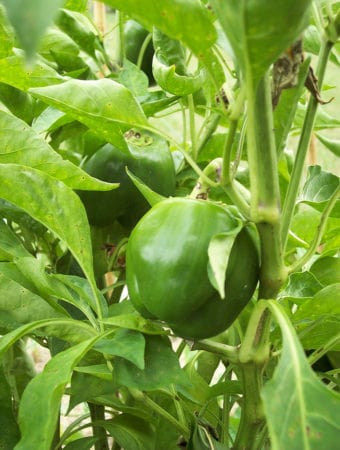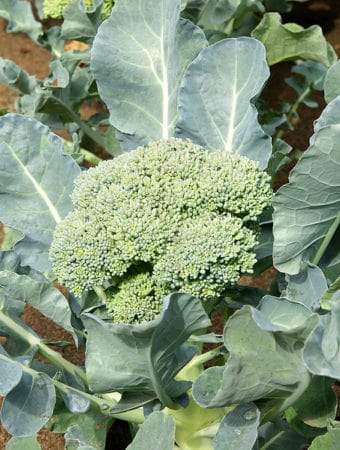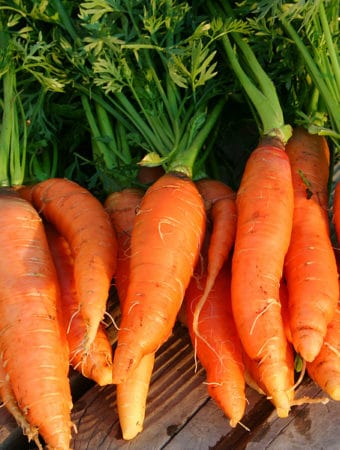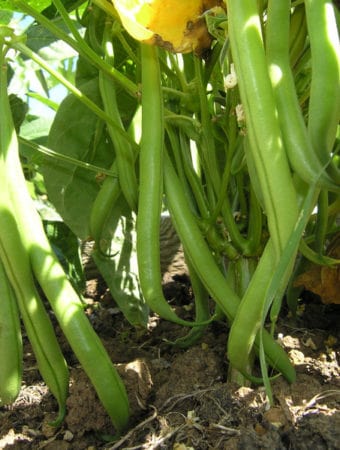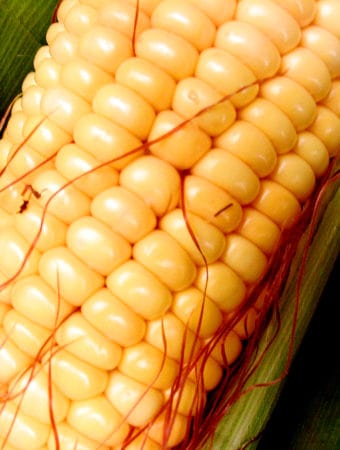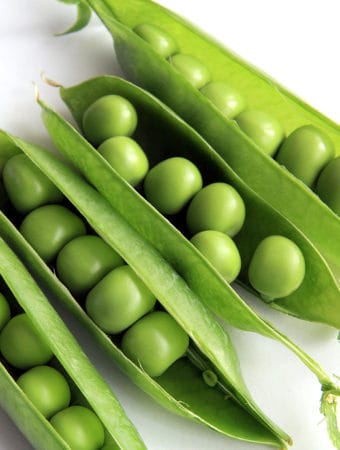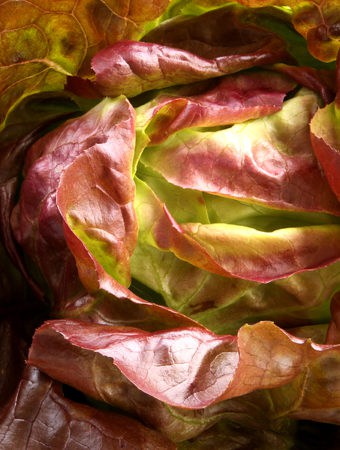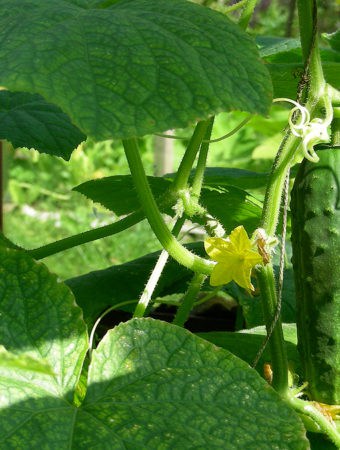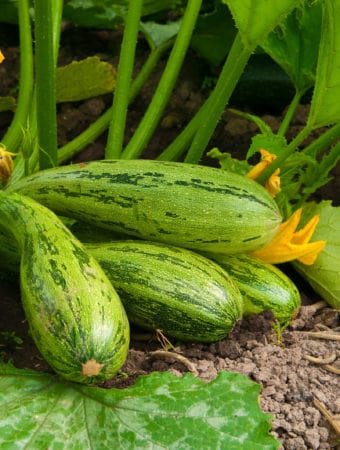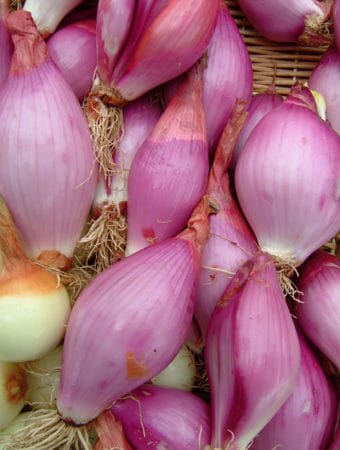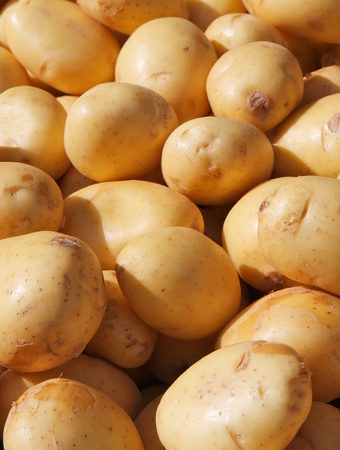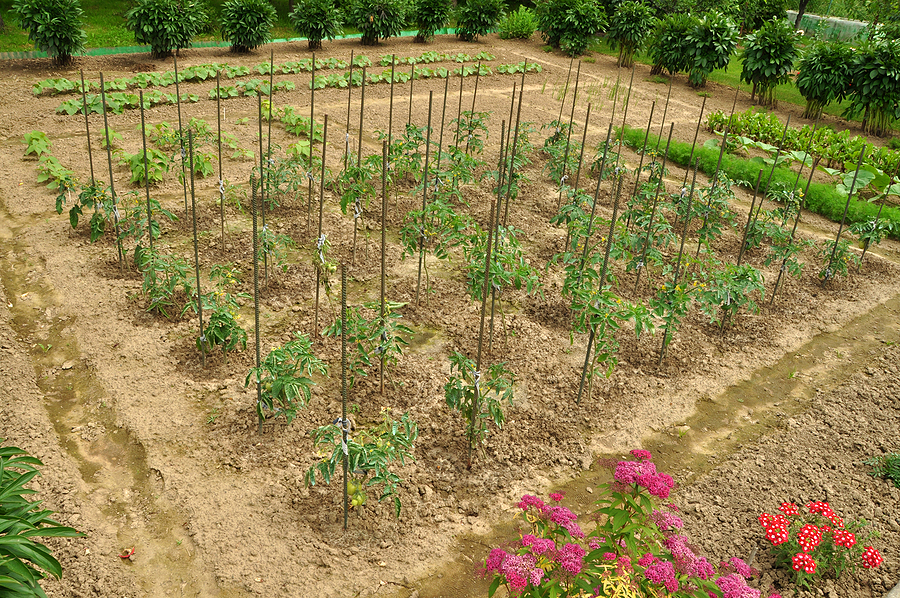
Late spring and early summer is the time to set out heat-loving crops–tomatoes, peppers, eggplants, cucumbers, zucchini, squashes, cucumbers, okra, and melons. Plant these crops where they will get plenty of sunshine for rapid growth and timely harvests. Work plenty of aged compost or commercial organic planting mix into the beds, mounds, and hills ahead of planting.
Summer vegetables should be kept evenly moist; transplants should be watered every day until they are well established. Don’t let tomatoes, peppers, eggplants, melons, zucchini, squashes, or cucumbers go dry–this will impede quick and even growth which is essential for sweet, tasty fruits at harvest.
Here is our round-up of summer crops planting guides (you’ll find more in the site Index):
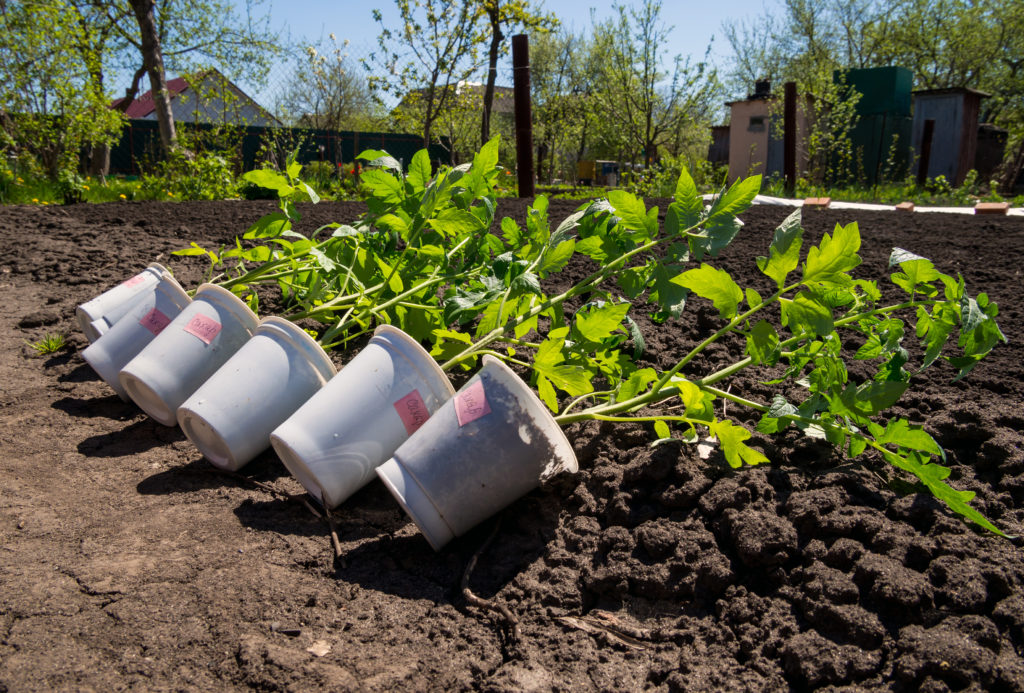
Transplanting Tomatoes
Set tomato seedlings into the garden in all locations this month. Indeterminate vining tomatoes will out produce determinate bush tomatoes. Indeterminate tomatoes produce fruit continuously until the first frost in fall; determinate tomatoes ripen fruit over a three to four week period and then stop.
Set tomatoes so that the soil balls are at least 1 inch (2.5cm) below the soil surface. Firm in plants and leave a slight depression around each plant to water in thoroughly. In dry regions, make sure tomato roots stay moist by inserting a 4-inch pot in the ground next to each plant with the top even with the soil level. Fill the pots with water regularly. You won’t need to water the surrounding soil.
Set a tomato cage around each plant or place a 4-foot (1.2m) stake alongside each plant tying the stem loosely to provide support. Determinate bush varieties do not require support.
Suckering is the pinching or cutting away of new lateral leaf branches that form in the V between the central main stem and leaf branches. Tomatoes sucker–or produce new branch growth–most of the season. Some new branches are necessary to shade tomatoes from sunscald, but most will steal energy away from the plant and need controlling.
More tips at How to Grow Tomatoes
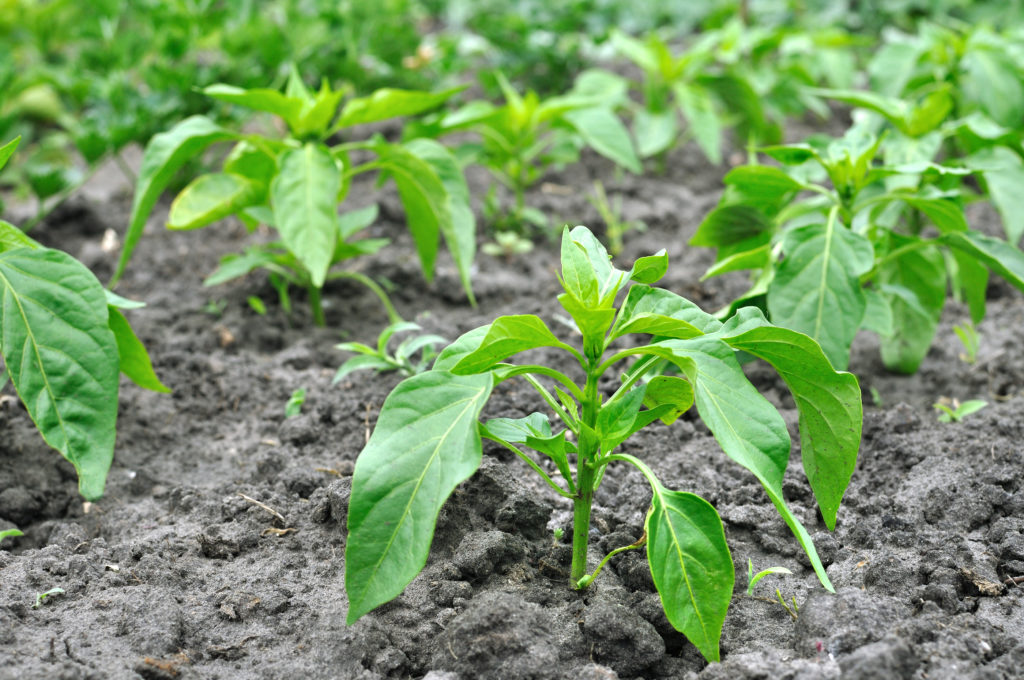
Planting Eggplants and Peppers
Be patient with eggplant and peppers. These crops require a soil temperature of 70°F (21°C), the daytime air temperature above 70°F, and night air temperature above 60°F (15°C). Sun and heat are essential for these plants to reach flowering and fruiting. Protect crops in the garden from cool temperatures. Hold off feeding until eggplants and peppers blossom then use moderate nitrogen and high phosphorus and potassium. Use Epsom salts to stimulate root structure.
More tips at How to Grow Eggplant and How to Grow Peppers
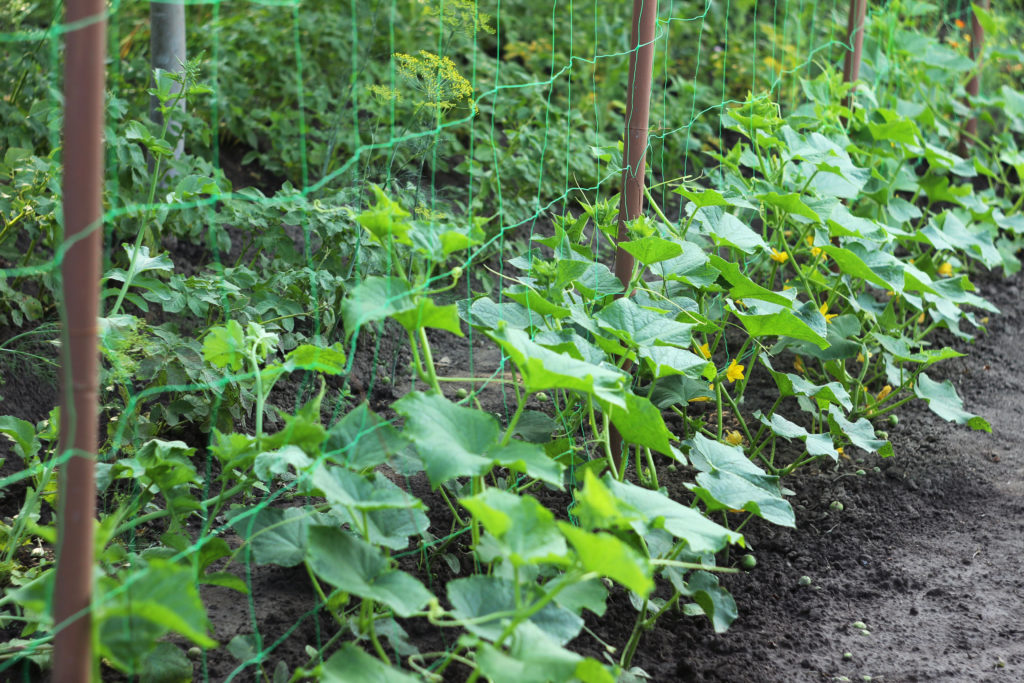
Planting Cucumbers
Like eggplants, cucumbers thrive in warm weather. Cucumbers mature quickly and are easy to look after. Pinch out the growing tips of cucumber plant when seven leaves have formed. This will keep the plant at a manageable size. Once flowers appear, water cucumbers regularly; avoid washing soil away from the roots. Feed every two weeks with liquid manure once the first fruits have started to grow.
More tips at How to Grow Cucumbers
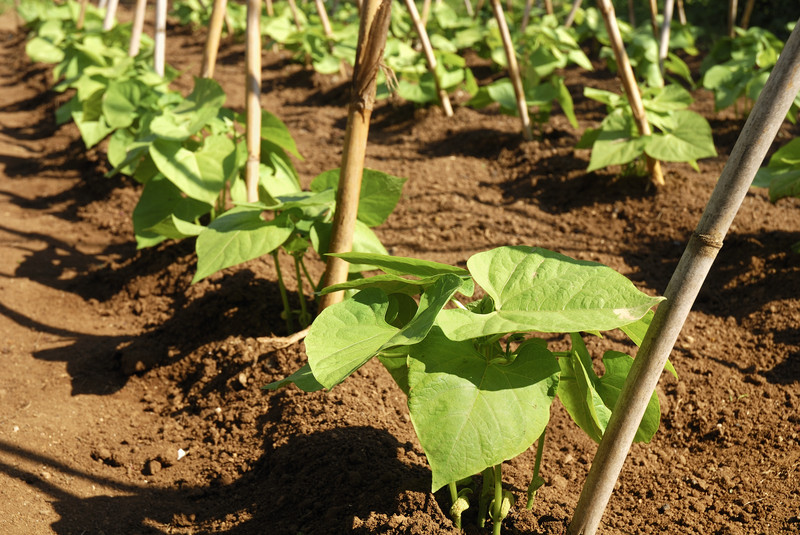
Planting Green Beans
Green beans and beans for drying can be planted in June. Cold soil can slow down bean growth, so once the soil temperature reaches 60°F (15°C), sow or transplant out beans. For optimal growth, the soil should be moist but not wet–too little or too much water can leaves beans susceptible to diseases and pests. Avoid overhead watering. Feed beans every two weeks for the first six weeks with compost tea. Good bean varieties for drying include ‘Yellow Eye’, ‘Soldier’, and ‘Navy’.
More tips at How to Grow Beans
Lima Beans
Lima beans thrive in warm dry weather. In cool-summer regions try ‘Jackson Wonder’, ‘Eastland Baby’, and ‘Packers’; in warm-summer regions plant ‘Dixie Butterpea’, ‘Fordhook 242’, and ‘Burpee’s Improved Bush Lima’. For a long harvest and the best yield, pick limas regularly.
More tips at How to Grow Lima Beans
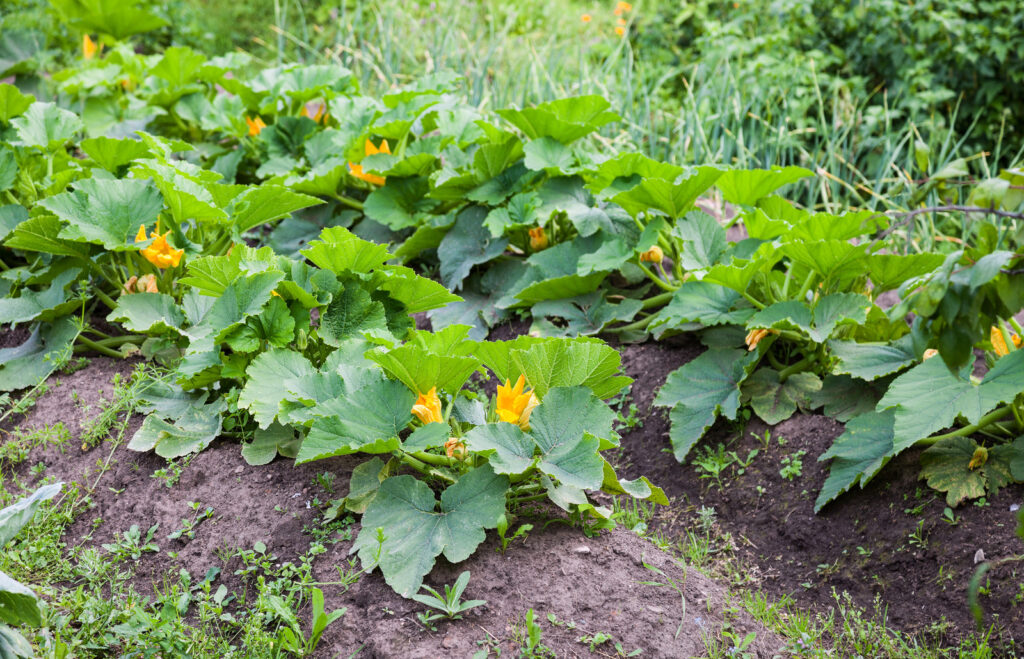
Planting Zucchini and Winter Squash
Plant summer squash, zucchini, and winter squash when the days are warm and long. Soil temperatures greater than 70°F (21°C) are optimal for direct seeding and growing summer and winter squashes. Retain as much of the soil ball as possible when transplanting and water in immediately. Squash are heavy feeders: choose an organic fertilizer high in nitrogen and moderate in phosphorus and potassium. Seaweed or fish emulsion is a good choice.
Winter squashes share the same growing requirements as summer squash but need an additional three months of frost-free growing time. Use row covers to protect squash from chilly temperatures. ‘Blue Hubbard’ and ‘Butternut’ are favorite winter squashes.
More tips at How to Grow Zucchini and How to Grow Winter Squash
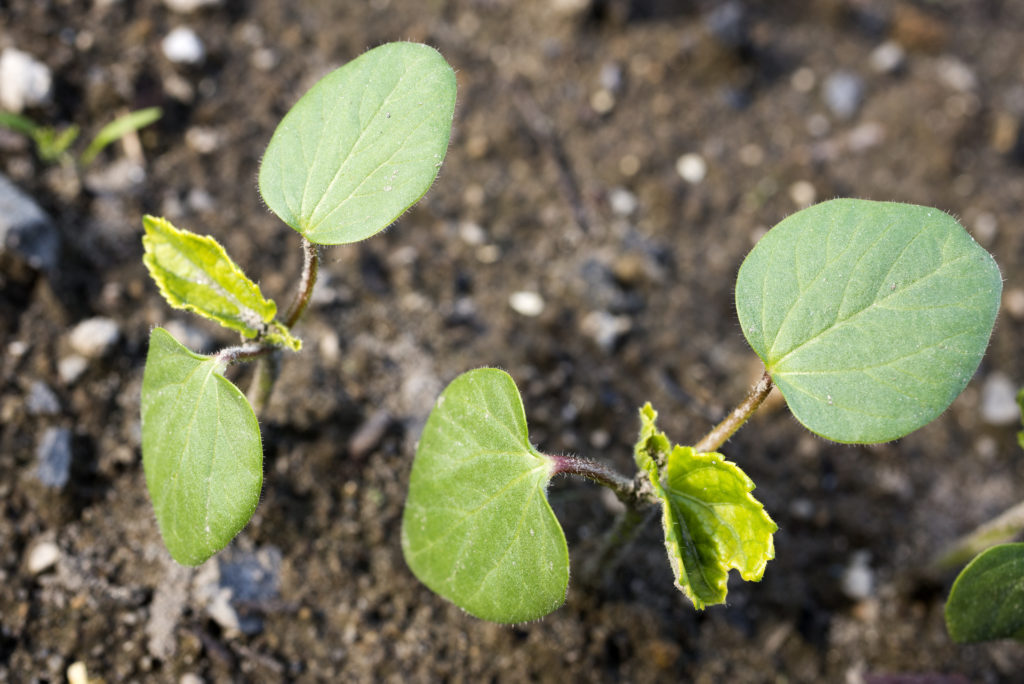
Planting Okra
Sow okra in wide rows once soil temperatures are greater than 70°F (21°C). Feed okra once a month with seaweed emulsion or compost tea. ‘Cajun Delight’ is a good choice in cool-summer regions.
More tips at How to Grow Okra
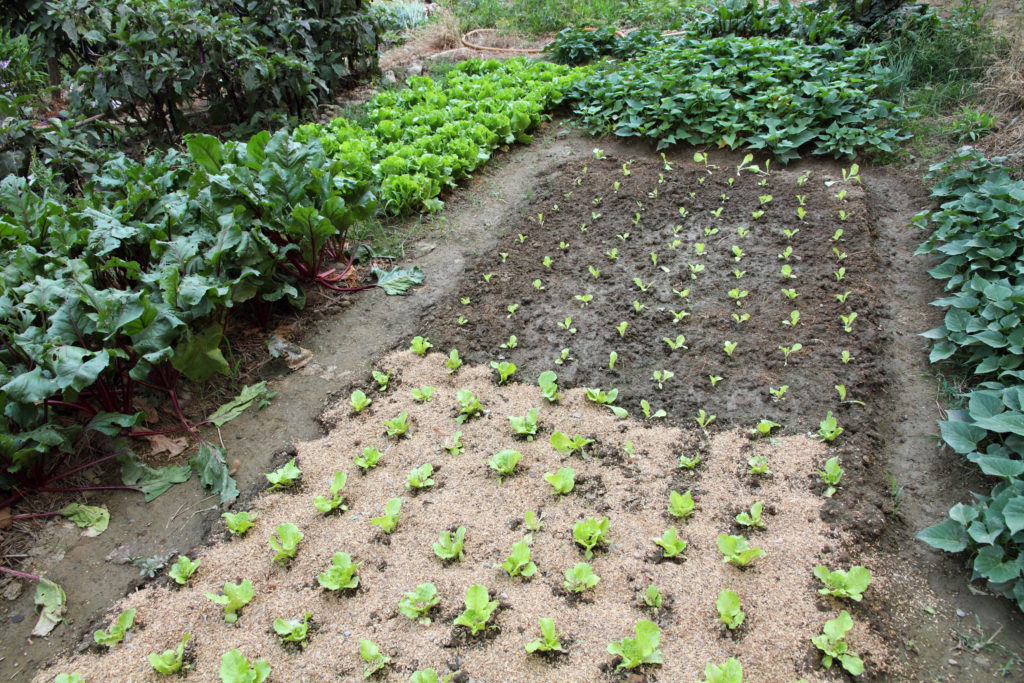
Tender Crop Successions
Make a plan for succession crops of tender warm-weather crops by looking ahead to the average first frost date in fall. Count back the number of days to maturity for each crop that you want to grow. Depending on the number of days left in your growing season, you may be able to plant one or more crop successions beginning this month. Make sure there is room in the garden for the crops that you want to grow. If unexpected cool weather happens, you may need to add a week or two to crops to allow for slowed ripening.
More tips at Succession Cropping
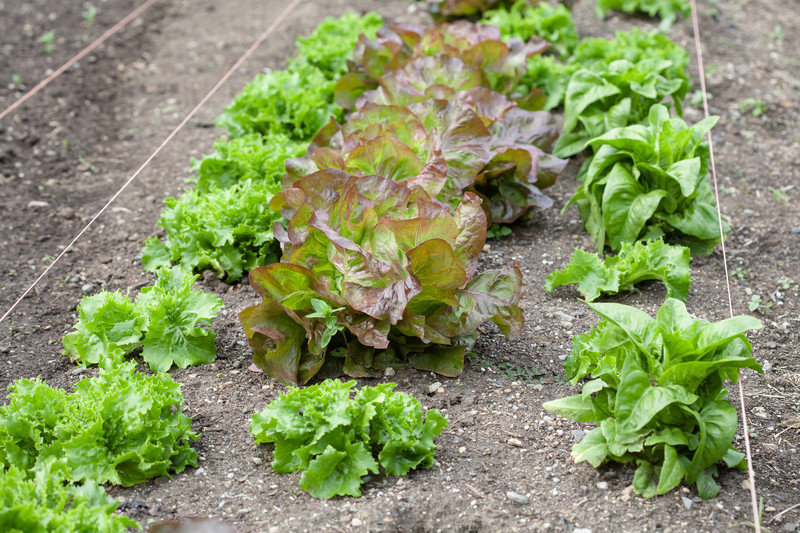
Planting Salad Crops
Salad greens–lettuce, mesclun, and spinach–do best in cool weather. In cool-summer regions, you can direct sow lettuce right through the summer. In mild or warm-summer regions, choose heat-resistant varieties. Rapid growth is the key to tender and tasty lettuce and salad greens. To encourage fast growth, give leaf crops soil rich in well-aged compost and side-dress plants with compost tea every two weeks until harvest.
To learn about lettuce that will grow in the summer heat see Lettuce for Spring and Summer Heat Resistance.
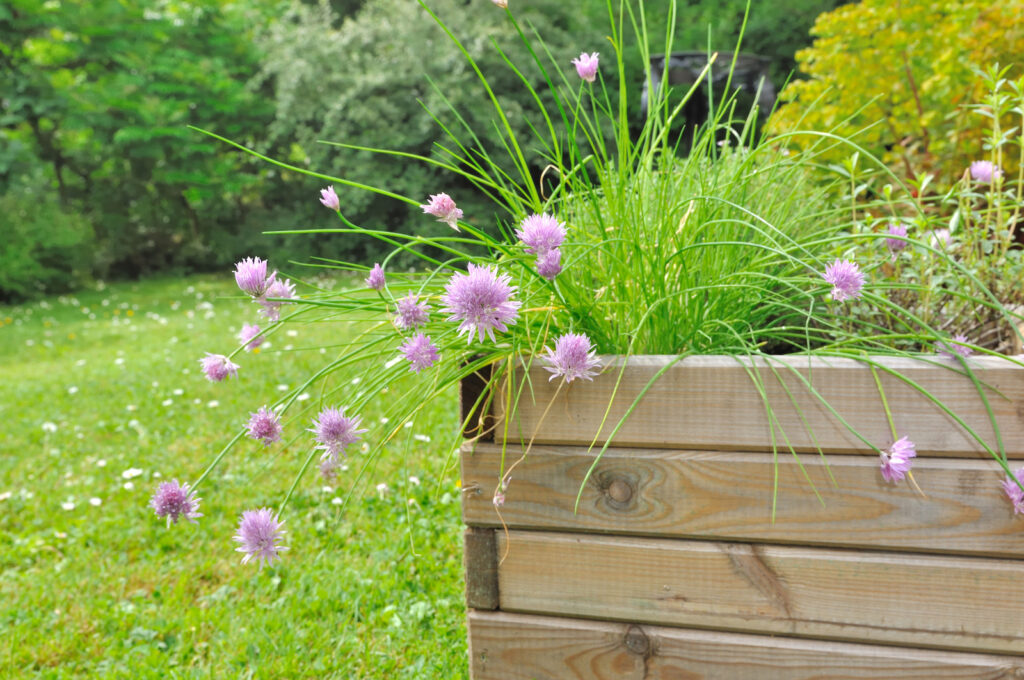
Herb Growing Tips
- Keep weeds down around herbs. Do not give the herb garden much water; most herbs come from dry Mediterranean countries and will not suffer if the roots go dry.
- Sow rows of chervil and dill, and thin established seedlings.
- Take and start cuttings of rosemary and sage.
- The leaves of many herbs will now be ready for harvest: mint, sage, and thyme can be used fresh, also chives, fennel, parsley, and sorrel.
- To freeze herbs for later use as flavoring: cut small springs from plants, wash, and blanch for one minute in rapidly boiling water. These can be placed in plastic bags and frozen for later use.
To browse articles about more than 30 herbs go to the Herb Category.
Feeding Crops
Spring-sown and transplanted crops will be ready for an extra nutrient boost as soon as they begin to flower. Side-dress young plants by drawing a circle with your finger around each plant at its drip line to a depth of about 1 inch (2.5cm) deep. Sprinkle a tablespoon of organic fertilizer around each plant or add a line of aged compost; work it gently into the soil with a hand tool and then water well. The extra nutrients will help blossoms develop into fruit and yield sweet-tasting vegetables.
To understand more about organic fertilizers see Organic Fertilizers and Soil Amendments
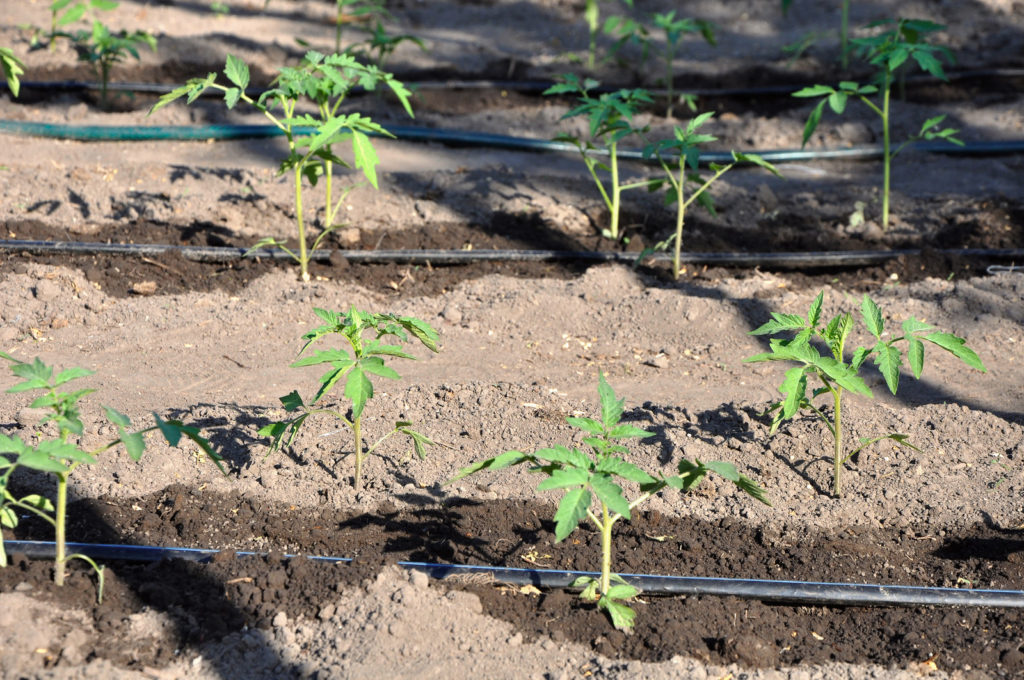
Watering Crops
When the weather is dry, water summer crops so that moisture reaches deep to the roots. A long, slow watering is best. Most crops want an inch of water each week–this means soaking the soil down to a depth of 4 to 5 inches (10-12cm). Stick your index finger into the soil to gauge watering. Water in the morning or evening when evaporation by the sun is low.
More tips at Watering Vegetables in Hot and Dry Weather
Weeding
Stay ahead of weeds. Weeds compete with vegetables for moisture and nutrients. Don’t let them get a foothold in the garden.
More about weeds at Vegetable Garden Weed Management
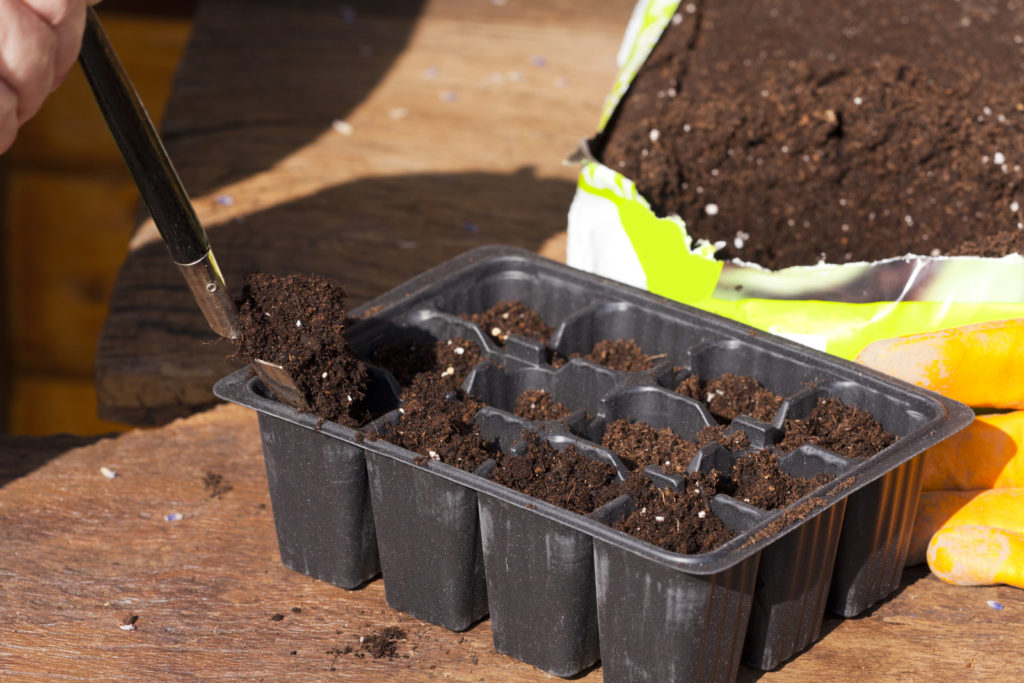
Planting for Fall and Winter Harvest
In USDA Zones 4-7 the shorter growing season means you can plan and plant cool-weather crops in June for harvest in fall and winter. Here are crops you can plant now:
- Brussels sprouts. Plant Brussels sprouts for harvest in winter. Brussels sprouts take 100 to 130 days to reach harvest. (In warm regions, wait until October to direct-sow Brussels sprouts.)
- Cabbage. Plant cabbage for harvest in late autumn. Late-season green varieties include ‘Storage No. 4’, ‘Scanbo’, and ‘Wirosa’. Red cabbage to plant includes ‘Rona’ and ‘Super Red 80’.
- Broccoli. Plant fall or winter broccoli varieties: ‘Arcadia’, ‘Marathon’, ‘Pirate’, and ‘Saga’ in summer for harvest in fall or early winter.
- Leeks. Leeks are often grown in soil that has been cleared of early potatoes. Plant long-season varieties for harvest from late summer through winter.
- Parsnips. Parsnips require 150 days to reach harvest. Start them now to harvest a few in fall but most will be harvested early next spring.
- Rutabagas. Sow rutabagas now for harvest in autumn. Rutabagas store well for months if the temperature is kept just above freezing. Sow thinly in drills ½ inch (1.2 cm) deep and 18 inches (45cm) apart.
- Celery. Plant self-blanching celery early this month. Set plants 12 inches (30cm) apart in rows 18 inches apart.
More about planting for autumn and winter harvest at Succession Planting Summer Into Autumn
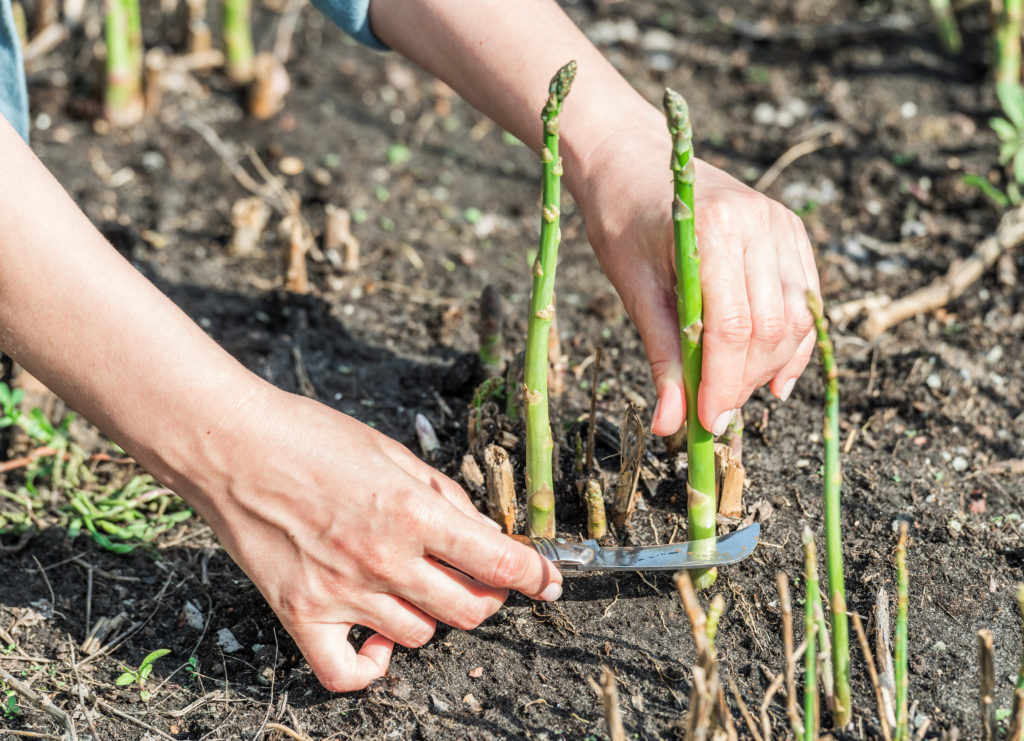
Harvest in June–Early Summer
Crops that come to harvest in early summer include asparagus, broad beans, broccoli, spring cabbage, kohlrabi, lettuce, salad onions, peas, early potatoes, radish, spinach, and chard.
Finishing Asparagus Harvest
Complete asparagus cutting by the middle of the month. Cut spears 3/8 inch in diameter and 6 to 8 inches (15-20cm) tall. Thinner spears should be left to grow into ferns. Set canes at the corners of the asparagus bed and tie twine around them to hold the ferny plants upright. If ferns are allowed to fall over the crowns may be damaged.



